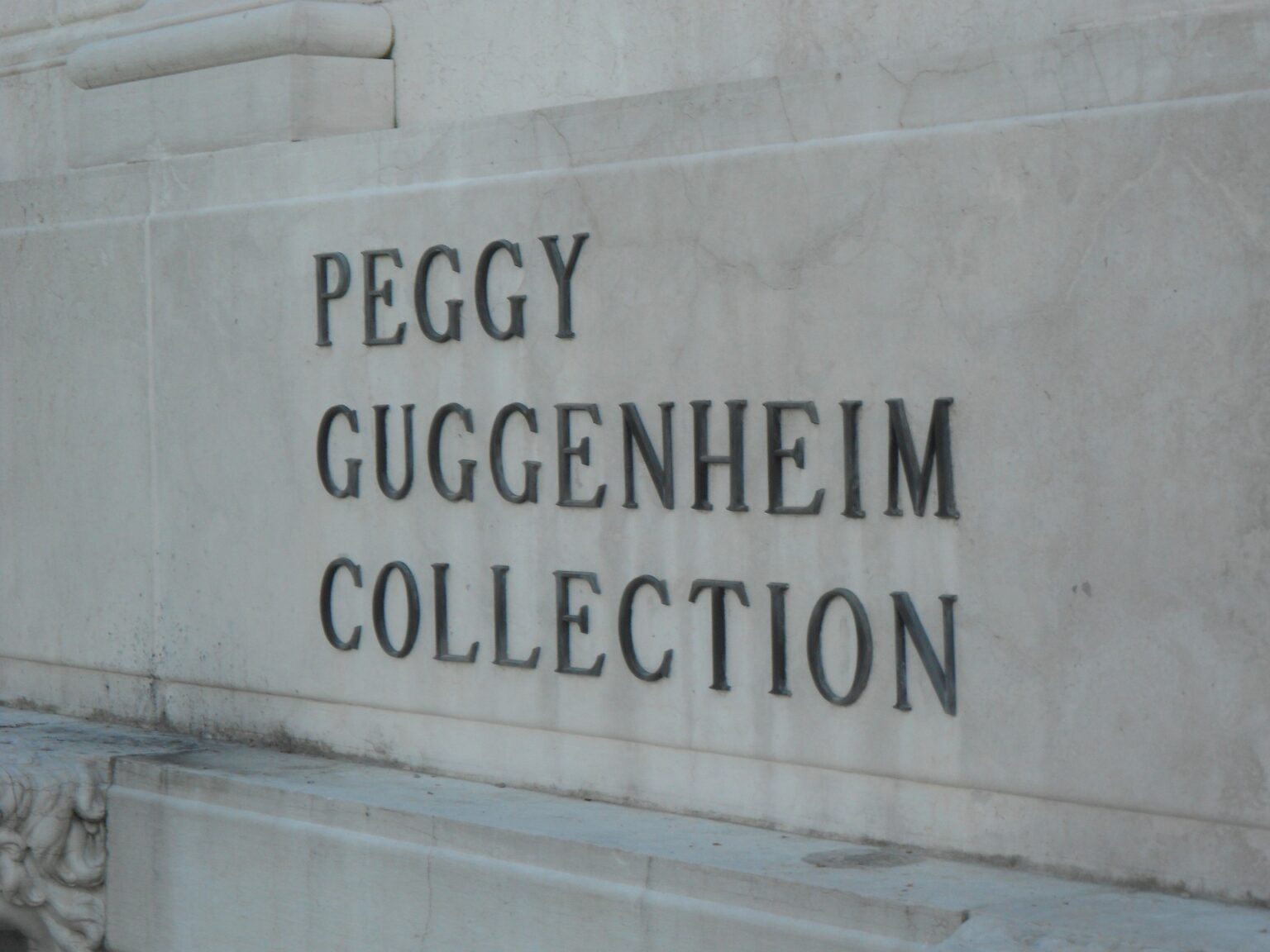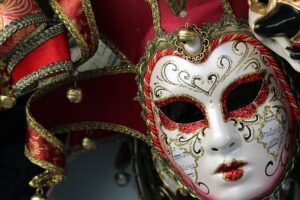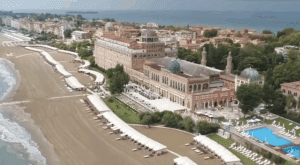Peggy Guggenheim in Venice — The Heiress Who Made Modern Art Her Life
She survived the Titanic, defied convention, and changed the art world forever. Peggy Guggenheim wasn’t just a collector — she was a force of nature. From Paris to New York to Venice, she gathered the most daring artists of her time, built friendships with legends, and turned her palazzo on the Grand Canal into one of the most iconic museums in the world.
🎟️ Skip the Line — Visit the Peggy Guggenheim Collection
🏛️ The Guggenheim Family — Fortune, Tragedy, and Genius
The story begins with Meyer Guggenheim, a Swiss immigrant who struck gold — quite literally — in the mining industry of 19th-century America. His empire transformed the Guggenheims into one of the wealthiest families in the United States, a dynasty built on silver, copper, and ambition.
One of his sons, Solomon R. Guggenheim, became an art visionary. He founded the Solomon R. Guggenheim Foundation in 1937 to champion modern art — a radical idea in its time. His museum in New York, designed by Frank Lloyd Wright, remains one of the world’s most recognizable works of architecture — a spiral of innovation and imagination.
But it was Solomon’s niece, Peggy Guggenheim, who would take the family name from business legend to artistic immortality.
🚢 A Titanic Beginning
Peggy was born in 1898, into a world of luxury — and loss. Her father, Benjamin Guggenheim, perished aboard the Titanic in 1912. As the ship went down, he reportedly dressed in his finest tuxedo and declared to a steward:
“Tell my wife I played the game straight to the end. No woman shall be left aboard this ship because Ben Guggenheim was a coward.”
At just 13 years old, Peggy lost her father — but inherited his daring spirit. That courage would define her entire life.
🌍 A Rebel in Paris
In the 1920s, Peggy left New York for Paris, where she entered the bohemian world of writers, poets, and painters. She frequented cafés where Ernest Hemingway and James Joyce argued about art, and befriended avant-garde artists like Marcel Duchamp, who became her mentor.
Duchamp taught her how to “see” — not just to buy what was beautiful, but what was new. Through him, she discovered the power of modern art and began collecting pieces by Constantin Brancusi, Jean Cocteau, and Man Ray.
Paris was also where Peggy’s love life became as bold as her art collection. She was married (and divorced) twice, had countless lovers, and lived with passionate intensity. As she once quipped:
“It’s not what you look at that matters, it’s what you see.”
🖼️ A Gallery Called “Art of This Century”
In 1938, Peggy opened her first gallery in London. The timing? Terrible. Europe was on the brink of war, and avant-garde art wasn’t exactly what people were buying. But she persisted — and when bombs began falling, she packed up her paintings and fled to America.
In New York, she opened Art of This Century, a groundbreaking gallery that introduced the U.S. to European Surrealism and championed emerging American artists. She gave Jackson Pollock his first solo show, supported Mark Rothko and Robert Motherwell, and turned her gallery into a creative sanctuary during wartime.
Without Peggy, the movement known as Abstract Expressionism might never have existed as we know it today.
🏠 Venice — Love at First Sight
After World War II, Peggy returned to Europe — and in 1949, she fell in love again. Not with a person, but with a city: Venice. She bought an unfinished palace on the Grand Canal — the Palazzo Venier dei Leoni — and filled it with her astonishing art collection.
From that day on, her home became a gathering place for artists, writers, and dreamers. Max Ernst, her ex-husband, often visited; so did Truman Capote, Jean Cocteau, and Yoko Ono. Guests recall Peggy hosting lunches on her terrace overlooking the canal, wearing oversized sunglasses, her dogs at her feet, and priceless Picassos hanging behind her.
Locals called her “la signora americana con i leoni” — the American lady with the lions. (The palace name “dei Leoni” comes from the stone lion statues guarding its entrance.)
🚶 Explore Venice Like Peggy — Hidden Art & Secret Stories
🏛️ Palazzo Venier dei Leoni — A Museum Like No Other
The Palazzo Venier dei Leoni is unique among Venetian palaces — unfinished, low to the water, yet perfectly elegant. Inside, every room tells a story: walls lined with Picasso, Dali, Kandinsky, Ernst, and Pollock. The terrace opens to the Grand Canal, where sunlight dances off sculptures by Giacomo Manzù and Alexander Calder.
Today, the Peggy Guggenheim Collection is one of the most visited modern art museums in Italy — intimate, inspiring, and deeply personal. It’s not a cold institution; it’s Peggy’s house, preserved exactly as she left it.
Her beloved dogs are even buried in the garden beside her — a touching reminder of her unconventional yet profoundly human life.
🖌️ Must-See Masterpieces
- Jackson Pollock, “Alchemy” (1947): One of Pollock’s greatest drip paintings — Peggy discovered him before the world did.
- Salvador Dalí, “The Birth of Liquid Desires” (1932): A surreal, sensual dreamscape from one of her closest artist friends.
- Wassily Kandinsky, “Composition 8” (1923): Abstract geometry and rhythm, painted at the dawn of modernism.
- Max Ernst, “The Antipope” (1942): A deeply personal work by Peggy’s husband and muse — painted during their New York years.
- Pablo Picasso, “The Poet” (1911): A Cubist masterpiece that changed how we see space and form.
💬 Peggy’s Influence — The Woman Behind the Revolution
Peggy Guggenheim didn’t just collect art — she believed in artists. She gave them rent money, dinners, and sometimes love. “I am not an art collector,” she once said. “I am a collector of artists.”
She was fearless, often buying works others called “crazy.” She once purchased a sculpture by Brancusi that U.S. customs officials tried to tax as “metal furniture.” She fought back — and won. Her instinct for innovation changed the course of 20th-century art.
When asked why she chose Venice as her final home, she smiled and said:
“It’s the only city in the world where I feel both lost and found.”
🕯️ Follow Peggy’s Venice — Private Art & Culture Tour
🌿 The Garden of Souls
Before you leave the museum, step into the sculpture garden — it’s pure poetry. Works by Henry Moore, Jean Arp, and Marino Marini sit among olive trees and quiet water fountains. Here, Peggy herself rests, surrounded by the art and dogs she loved most.
🎟️ Visiting the Peggy Guggenheim Collection
The museum sits in the heart of Dorsoduro, near the Accademia Gallery and across from Punta della Dogana. You can reach it easily by vaporetto — just stop at Accademia or Salute.
For the best experience:
- ⏰ Visit early morning or late afternoon to avoid crowds.
- 🎧 Book a guided tour or audio experience to understand the personal stories behind each painting.
- ☕ Enjoy a coffee in the sculpture garden — it’s one of Venice’s quietest corners.
🎫 Reserve Your Peggy Guggenheim Museum Tickets
🚤 Get Your Vaporetto Pass to Arrive by Water
💫 Peggy Guggenheim — Venice’s Eternal Muse
When Peggy died in 1979, she left behind not just a collection, but a philosophy — that art should be lived with, not locked away. Her spirit still lingers in every brushstroke, every sculpture, every wave that laps at the steps of her palazzo.
Visiting the Peggy Guggenheim Collection isn’t just about seeing art — it’s about meeting the woman who dared to rewrite its history.
🎨 Discover Venice with a Local Art Expert
FAQs About the Peggy Guggenheim Collection in Venice
Where is the Peggy Guggenheim Collection located?
The museum sits on the Grand Canal in Dorsoduro, inside Peggy’s former home — Palazzo Venier dei Leoni. It’s easy to reach by vaporetto: stop at Accademia or Salute. To explore this area like a local, combine your visit with our Off-the-Beaten-Path Orientation Tour for hidden stories and nearby art gems.
How can I get tickets to the Peggy Guggenheim Collection?
You can book skip-the-line tickets directly through our Peggy Guggenheim Collection Fast Track Ticket. Advance booking is highly recommended — especially during Carnival or summer weekends. For an even richer experience, pair your visit with a guided Venice Art & Culture Tour to see how Peggy’s legacy connects with other masterpieces around the city.
What are the must-see artworks inside the museum?
Don’t miss Jackson Pollock’s “Alchemy,” Kandinsky’s “Composition 8,” Picasso’s “The Poet,” and Max Ernst’s “The Antipope.” Each reflects Peggy’s fearless eye for innovation. After touring the galleries, relax in the sculpture garden where Peggy and her beloved dogs rest — or extend your art journey with a visit to Punta della Dogana and Palazzo Grassi nearby.







